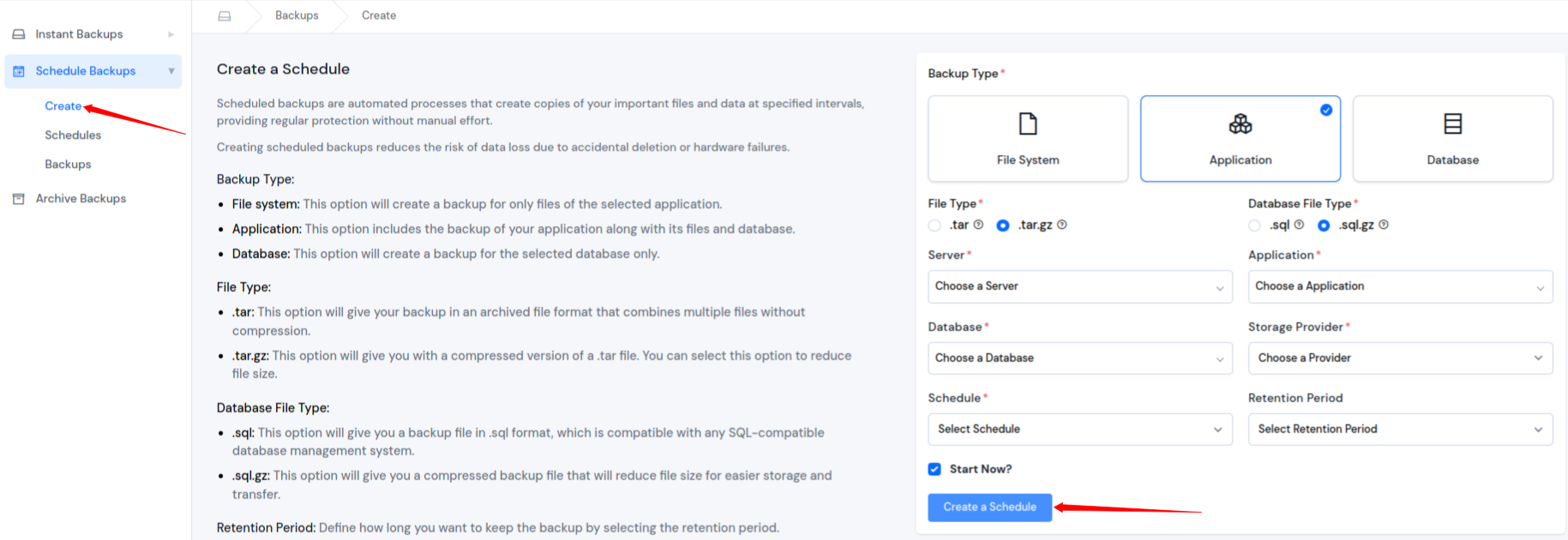Schedule Backup
The Schedule Backup feature allows you to set up automated backup schedules for your server, ensuring that your data is regularly backed up without manual intervention.
Create a Backup Schedule
To create a backup schedule, follow these steps:
- Log In: Log in to your ServerAvatar account and navigate to the Backup section in the sidebar.

-
Select Schedule Backup: Click on the Schedule Backup >> Create tab to create a schedule backup.
-
Fill in the Backup Details:
-
Backup Type: Choose from one of the following backup types:
- File System: This option will create a backup for only files of the selected application.
- Application: This option includes the backup of your application along with its files and database.
- Database: This option will create a backup for the selected database only.
-
File Type: Select the file type for the backup:
- .tar: This option will give your backup in an archived file format that combines multiple files without compression.
- .tar.gz: This option will give you with a compressed version of a .tar file. You can select this option to reduce file size.
-
Database File Type: Choose the database file type (if applicable):
- .sql: This option will give you a backup file in .sql format, which is compatible with any SQL-compatible database management system.
- .sql.gz: This option will give you a compressed backup file that will reduce file size for easier storage and transfer.
-
Server: Select the server for the backup, which can be associated with File System, Application, or Database.
-
Application: Choose the application (if applicable) for File System or Application backup.
-
Database: Select the database (if applicable) for Application or Database backup.
-
Storage Provider: Choose a storage provider where you want to store the backup.
-
Provider Account: Select the account of the storage provider if you have multiple storage accounts configured.
-
Schedule: Specify when the backup should run (e.g., every hour, every day, every week, etc.).
-
Retention Period: Define how long you want to keep the backup by selecting the retention period.
-
Start Now: Select the "Start Now" checkbox if you want to start the backup process immediately after creating the schedule.
-
-
Create a Schedule: After filling in the required details, click the "Create a Schedule" button to set up the automated backup schedule.

List of Schedules
Here, you can view a list of all your schedules. This list includes the following columns:
-
Provider: The storage provider where the backup is stored.
-
Application: The associated application for the backup (if applicable).
-
Database: The associated database for the backup (if applicable).
-
Schedule: The schedule frequency or time when the backup is set to run.
-
Retention Period: The duration for which the backup is kept before being deleted.
-
Status: The current state of the backup schedule.
-
Total Backups: The total number of backups made under the schedule.
-
Last Backup At: The date and time when the most recent backup was completed.
-
Next Backup At: The date and time when the next backup is scheduled to run.
-
Actions: This column provides options to edit, pause, or delete the backup schedule.
- Pause: You can use the "Start/Pause Schedule Backup" icon button to manually start or pause a scheduled backup.
- Edit: You can use the "Edit" icon button to modify the existing backup schedule.
- Delete: You can use the "Delete" icon button to permanently removes the backup schedule from the list.

To access the list of scheduled backups:
-
Navigate to the Schedule Backups >> Schedules tab in the sidebar.
-
You will see a table with the mentioned columns.
-
You can perform actions on individual schedules as needed, such as modifying the schedule, pausing, or initiating backups.
By setting up regular backup schedules and using the "Start/Pause Schedule Backup" button when necessary, you can ensure that your data is consistently protected, and you have full control over your backup processes.
List of Scheduled Backups
Here, you can view a list of all your scheduled backups. This list includes the following columns:
-
Provider: The storage provider where the backup is stored.
-
Application: The associated application for the backup (if applicable).
-
Database: The associated database for the backup (if applicable).
-
Status: The current status of the backup, indicating whether it's completed or in progress.
-
Type: The type of backup (File System, Application, or Database).
-
Price: The cost associated with the backup (if applicable).
-
Created At: The date and time when the backup schedule was created.
-
Actions: You can see the icon to Download or Restore the backup. You can perform actions on individual backups as needed.
-
List of Backups: You can view a list of all backups taken based on this schedule, including their names, creation dates, and other relevant details.
To access the list of scheduled backups:
-
Navigate to the Schedule Backups >> Schedules tab in the sidebar.
-
You will see a table with the mentioned columns.

Note: Remember to manage your backup schedules wisely to avoid excessive resource usage.
For more information on the other backup features like "Instant Backup" and "Archive Backup," refer to the respective sections in the sidebar.
That's it! You now know how to create, manage, and control backup schedules using ServerAvatar's intuitive interface.